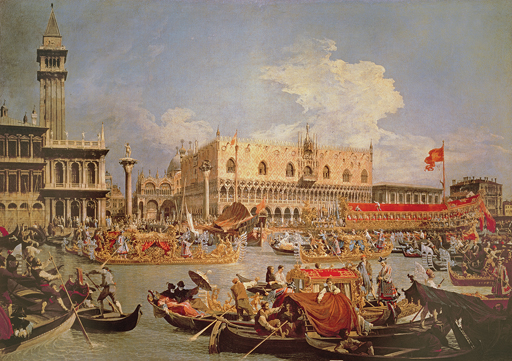1 Welcome to early modern Europe
You will begin the study of early modern Europe with an account by Richard Pococke, an English visitor to Venice on Ascension Day (the Christian festival marking the day when Christ is believed to have ascended into heaven) in 1734. (Figure 1 shows the ceremony in 1730.) There are some unfamiliar words here. The Doge was the elected ruler of Venice, and the procurators were officials of the city. The Pope’s nuncio was a diplomat sent from the Vatican. There is also a phrase in Latin, ‘testimonium perpetui dominii’, which is a misquotation of the ceremonial words Desponsamus te, mare, in signum veri perpetuique domini (‘We wed thee, sea, in the sign of the true and everlasting Lord’).
We saw the ceremony of the Doges marrying the sea one of the finest sights in the world. About 9 I saw the Doge at Mass in the chapel of the Palace with the Nobles, thence they went in procession to the Bucentaur or fine Galley, with flags displayed, the sword of state going after the Doge before the Procurators and head Nobles, the Popes Nuncio on the right of the Doge, and the Emperors Ambassador […] on the left […] the Doge went in to the Bucentaur […] being sett off shes rowd by 44 oars, two fine large Galleys of the state row at some distance after, the boats of ambassadors keep near the stern and many thousand Gondolas all about, musick in several boats, the bells all ringing the ships firing as it passd by […] thus they went above a mile to the Isle of St Nicolas where the army of the state were drawn up […] the vessel turnd, and [the Doge] […] threw the ring in to the sea making use of words to this purpose by this ring I marry the sea in testimonium perpetui dominii, on which all the Guns fird, and they returnd to St Nicolas and landing went in procession to the church where mass was celebrated solemnly by the Bishop calld the Patriarch of Venice.

What was your response to reading this passage? It probably prompted many questions. How can you marry a city to the sea, and why would you want to? Why was this ceremony so significant that important people like ambassadors and thousands of Venetian citizens followed the procession?
By the end of this course you should be able to answer at least some of these questions – not because you will spend a lot of time studying festivals in Venice, but because you will explore the fundamental aspects of life in early modern Europe, including the role of religion, the structure of society, the organisation of work and trade, and developments in knowledge and ideas. This gives you a set of tools to understand early modern life, including its apparently strange and dramatic public rituals.
This course asks some very basic questions – What do we mean by ‘early modern’? What was ‘Europe’ at this time? – and introduces you to a set of themes that will help to structure your understanding. So, it’s time to leave Venice and the Doge’s barge, and turn to early modern Europe, its society and culture.
